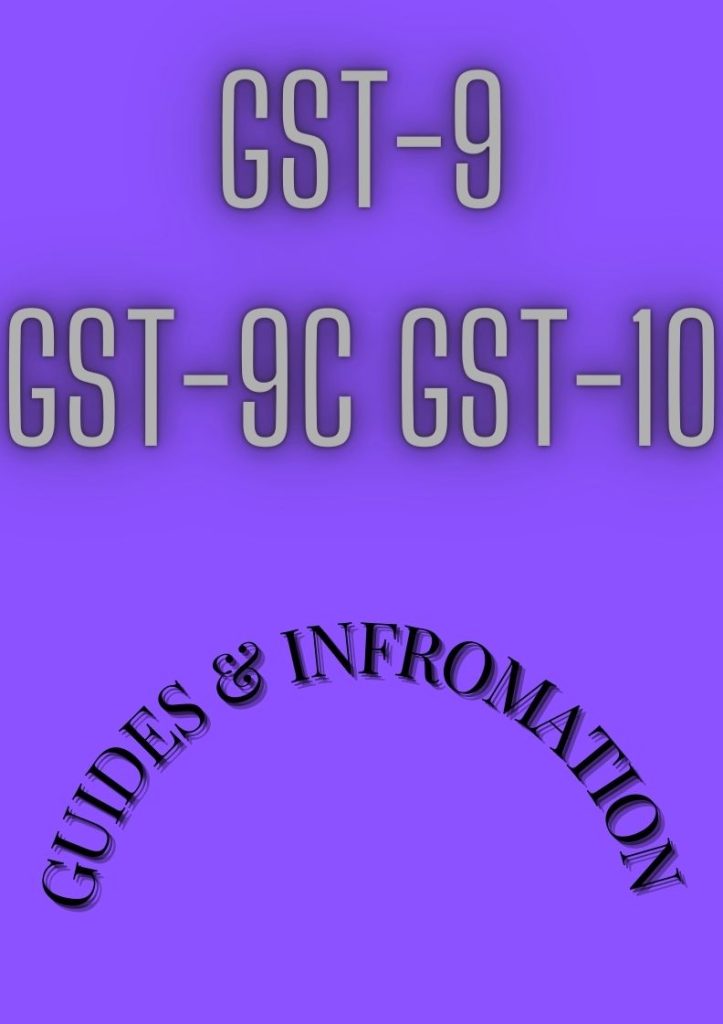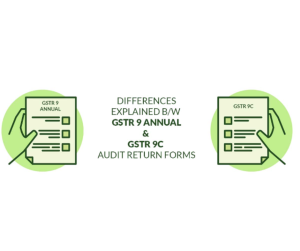
The taxation environment in many nations has changed as a result of the Goods and Services Tax(GST) structure, which has replaced a convoluted network of indirect taxes with a single, efficient system. In this context, the GST-9, often referred to as the annual return, becomes an important record that summarizes a taxpayer’s financial activities for a whole fiscal year. We explore the complexities of GST-9 in this extensive guide, elucidating its intent, importance, constituent parts, and wider implications for businesses and tax compliance.
Videos for gst-9 and gst-9c :Youtube

A.Comprehending the Fundamentals of GST-9
- 1. The goal of GST-9 :-The GST-9 provides a comprehensive overview of a taxpayer’s financial operations within a given fiscal year. It is an extensive document that compiles all of the taxpayer’s transactions into one cohesive whole, giving tax authorities a broad picture of their company’s activities. Ensuring accountability, transparency, and compliance with GST regulations is the main goal of GST-9.

- 2. Applicability and Who Must File GST-9: Every regular taxpayer who is enrolled for GST must submit a GST-9 form once a year. This comprises companies that meet the required turnover levels and are involved in the provision of goods or services. Nonetheless, several taxpayer classifications are excused from reporting GST-9, including input service distributors and composition dealers.
- 3. GST-9 Components: Financial Information: During the fiscal year, supplies made both inside and outside the country must be disclosed in conformity with GST-9. Information about supplies subject to reverse charge, exempt supplies, and non-GST supplies are included in this. The taxpayer must submit a detailed summary of all of their financial dealings.
B. Input Tax Credits (ITC):

Reporting of Input Tax Credits that are accessed, reversed, and ineligible is a crucial component of GST-9. The purpose of this part is to ensure accuracy and compliance by balancing the taxpayer’s reported ITC with the actual tax paid on their purchases.
C. Tax Payments and Refunds:
Details of all taxes paid throughout the fiscal year, including both State and Central GST (CGST and SGST), must be provided by taxpayers. Furthermore, all requested refunds must be accurately recorded in the GST-9 form throughout the year.
4. GST-9’s Significance:
A.Transparency and Compliance:
A crucial part of guaranteeing adherence to GST laws is GST-9. By giving a thorough rundown of all financial activities, it encourages taxpayer accountability and transparency.
B. Tax Authorities’ Assessment Tool:
Tax authorities use the data in GST-9 to evaluate the correctness of tax payments, spot any inconsistencies, and, if required, carry out audits. It is a useful instrument for managing taxes.
C. Reconciling Input Tax Credits:
The reconciliation of Input Tax Credits (ITC) between the financial statements and GST filings is made easier by the comprehensive reporting of ITC in GST-9. By going through this procedure, it is made sure that the tax credits sought match the real taxes paid.
Getting Around the Main GST-9 Components
1. Financial Data:
A. External Supplies
Concerning taxable, exempt, and non-GST supplies, taxpayers are required by GST-9 to submit a comprehensive account of their outward shipments. This section, which provides an overview of the scope and character of the company’s operations, makes up the majority of the document.
B. Inward Supplies:
All purchases made during the fiscal year must be documented as part of the inbound supply reporting process. This covers imports as well as supply from both registered and unregistered individuals.
C. Items Subject to Reverse Charge:
When a reverse charge mechanism applies and the recipient is required to pay tax, the specifics of the supply must be carefully recorded in GST-9.
D. Non-GST and Exempt Supplies:
GST-9 mandates the disclosure of supplies that are beyond the scope of the GST framework and Those are free from GST to provide an accurate depiction.
2. Input Tax Credits(ITC):
A. ITC Availed:
Details about the Input Tax Credits that taxpayers used for their purchases throughout the fiscal year must be provided. This covers both the SGST and CGST parts.
B. ITC Reversed:
In certain situations, taxpayers may need to reverse Input Tax Credits. GST-9 mandates the reporting of such instances, ensuring that the reconciliation process is thorough and accurate.
C. Ineligible ITC:
The identification and reporting of ineligible Input Tax Credits is crucial for maintaining the integrity of the GST system. GST-9 requires taxpayers to disclose any ITC claim that does not comply with GST regulations.
3.Tax Payments and Refunds:
A. Tax Paid:
Accurate documentation of tax payments made during the fiscal year must be included in GST-9. This covers payments for both SGST and CGST.
B. Refunds Claimed:
Any refunds claimed by the taxpayer should be reported in this section, providing tax authorities with a clear picture of the financial transactions involving refunds.
The Relevance of GST-9C in the Compliance Landscape
While GST-9 provides a comprehensive overview of a taxpayer’s financial activities, it is accompanied by GST-9C, the reconciliation statement. GST-9C plays a crucial role in ensuring the accuracy and reliability of the information provided in GST-9.
- Purpose of GST-9C:

A.GST-9 Reconciliation with Audited Financial Statements:
GST-9C acts as a link between the taxpayer’s audited financial statements and yearly return (GST-9). To find any differences and guarantee that financial records and GST returns are in line with one another, a careful comparison is required.
B. Auditor’s Certification:
One of the requirements of GST-9C is a certified reconciliation statement by a trained auditor. The auditor’s certification assures tax authorities of the accuracy of the taxpayer’s financial information and lends credibility to the reconciliation procedure.
- Key Components of GST-9C:
A. Reconciliation of Turnover:
The turnover stated in GST-9 and the turnover recorded in the audited financial accounts are carefully reconciled in GST-9C. Any discrepancies are found and dealt with.
B. Reconciliation of Tax Paid:
One essential part of GST-9C is the reconciliation of the tax declared in GST-9 and the tax paid according to the financial statements. By doing this, the accuracy of the tax liabilities is guaranteed.
C. Auditor’s Observations and Findings:
GST-9C provides an avenue for the auditor to make observations and findings regarding the reconciliation process. Any discrepancies or areas of concern are communicated in this section.
3.Significance of GST-9C:
A. Strengthening Trust and Dependability:
Improved credibility and dependability of the data in GST-9 are the results of GST-9C. An extra degree of assurance is added when a certified auditor participates in the reconciliation process.
B. Facilitating Seamless Audits:
By providing a certified reconciliation statement, GST-9C facilitates seamless audits by tax authorities. The reconciliation process minimizes the risk of errors or inconsistencies in financial reporting.
The Culmination: GST-10 – Final Return
GST-10, the final return, marks the conclusion of a taxpayer’s journey within the GST framework. It comes into play when a taxpayer decides to cease their business operations.
1.Purpose of GST-10:
A. Formal Closure of Business:
A GST-10 is submitted to formally close a business. It is the end of business operations, marked by the stopping of supplies coming in and going out.
B. Reporting Closing Stock and Input Tax Credits:
On the date of cessation, taxpayers must provide information about the closing stock and any applicable input tax credits. This guarantees a thorough and accurate depiction of the company’s financial status at closing.
C. Addressing Liabilities and Refunds:
The final return gives tax authorities a thorough picture of the financial situation at the time of firm closure by including information on refunds and any outstanding liabilities.
Significance of GST-10:
A. Smooth Exit from GST Framework:
For enterprises that want to close their doors, GST-10 guarantees a seamless transition out of the GST framework. Liabilities and refunds are handled, concluding the tax compliance process.
B. Comprehensive Financial Snapshot:
The details provided in GST-10 offer tax authorities a comprehensive snapshot of the business’s financial position at the time of closure. This assists in the efficient handling of any remaining tax matters.
Conclusion:
Handling the Intricacies of GST-9 To sum up, the GST-9 is a crucial document in the GST system that acts as an extensive record of a taxpayer’s financial transactions for the entire fiscal year. Its importance goes beyond compliance; it includes accountability, transparency, and the efficient operation of the larger tax system.
Examining the essential elements of GST-9, such as the thorough financial transaction reporting and the input tax credits reconciliation, illuminates the painstaking nature of the compliance procedure. Moreover, the concurrent presence of GST-9C underscores the need of precision and dependability, as the participation of certified auditors contributes an extra degree of legitimacy to the reconciliation procedure.
It is crucial to stay up to date with the current standards and ensure rigorous compliance with GST-9 and its accompanying forms as businesses evolve and tax systems undergo changes. By doing this, companies not only comply with regulations but also improve the general effectiveness and openness of the tax system.
GST-9 continues to be a pillar of the compliance process in the ever-changing tax landscape, connecting the dots between regulatory obligations and financial activities. Knowing and grasping the subtleties of GST-9 is essential to guaranteeing a smooth and legal taxing experience as companies continue to negotiate the intricacies of GST.

more information :-Gst-clicker.com
Filling Gst-9 ,Gst-9C



